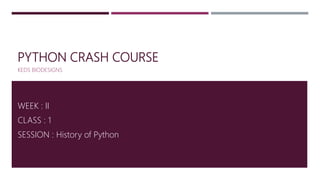
Machine learning session 1
- 1. PYTHON CRASH COURSE KEDS BIODESIGNS WEEK : II CLASS : 1 SESSION : History of Python
- 2. WHAT IS PYTHON? • Python is scripting languages. • Scripting languages are programming languages that are typically written using high-level programming constructs, which makes them easy to learn. • Python is an interpreted, interactive, object-oriented programming language. • Python high-level general-purpose programming language are used especially for developing Web applications.
- 3. WHY TO LEARN PYTHON? Python is a high-level, interpreted, interactive and object-oriented scripting language. Python is designed to be highly readable. It uses English keywords frequently where as other languages use punctuation, and it has fewer syntactical constructions than other languages. Python is a MUST for students and working professionals to become a great Software Engineer specially when they are working in Web Development Domain. I will list down some of the key advantages of learning Python: Python is Interpreted − Python is processed at runtime by the interpreter. You do not need to compile your program before executing it. This is similar to PERL and PHP. Python is Interactive − You can actually sit at a Python prompt and interact with the interpreter directly to write your programs. Python is Object-Oriented − Python supports Object-Oriented style or technique of programming that encapsulates code within objects. Python is a Beginner's Language − Python is a great language for the beginner-level programmers and supports the development of a wide range of applications from simple text processing to WWW browsers to games.
- 4. WHY IS PYTHON CLASSES? • Python training will help you in programming language developed for text manipulation which will be used wide range of tasks. • Training will help you to develop dynamic pages in web development environment in a very powerful way.
- 5. APPLICATIONS OF PYTHON As mentioned before, Python is one of the most widely used language over the web. I'm going to list few of them here: Easy-to-learn − Python has few keywords, simple structure, and a clearly defined syntax. This allows the student to pick up the language quickly. Easy-to-read − Python code is more clearly defined and visible to the eyes. Easy-to-maintain − Python's source code is fairly easy-to-maintain. A broad standard library − Python's bulk of the library is very portable and cross-platform compatible on UNIX, Windows, and Macintosh.
- 6. APPLICATION Interactive Mode − Python has support for an interactive mode which allows interactive testing and debugging of snippets of code. Portable − Python can run on a wide variety of hardware platforms and has the same interface on all platforms. Extendable − You can add low-level modules to the Python interpreter. These modules enable programmers to add to or customize their tools to be more efficient. Databases − Python provides interfaces to all major commercial databases. GUI Programming − Python supports GUI applications that can be created and ported to many system calls, libraries and windows systems, such as Windows MFC, Macintosh, and the X Window system of Unix. Scalable − Python provides a better structure and support for large programs than shell scripting
- 7. WHY PYTHON IS THE MOST POPULAR LANGUAGE USED FOR MACHINE LEARNING • First of all, there is nothing like machine learning programming language. People may be calling it because nowadays it has become popular. The reason for its popularity being 'easy to learn'. • Python is simple, elegant, consistent, and math-like. Python code has been described as readable pseudo code. • Python is the tool of choice for people who want to explore and apply machine learning for their research projects - data analysis, pattern recognition, etc.
- 8. WHAT IS PYTHON DATA SCIENCE? One of the main reasons why Python is widely used in the scientific and research communities, is because of its ease of use and simple syntax which makes it easy to adopt for people who do not have an engineering background. It is also more suited for quick prototyping. 1. Python is slow and won’t be able to implement custom logic. 2. Python is fairly hard to bind to from C++ or even C. 3. Python is stuck in a gridlocked transition from version 2.7 to 3.0 Why is Python so popular for data science?